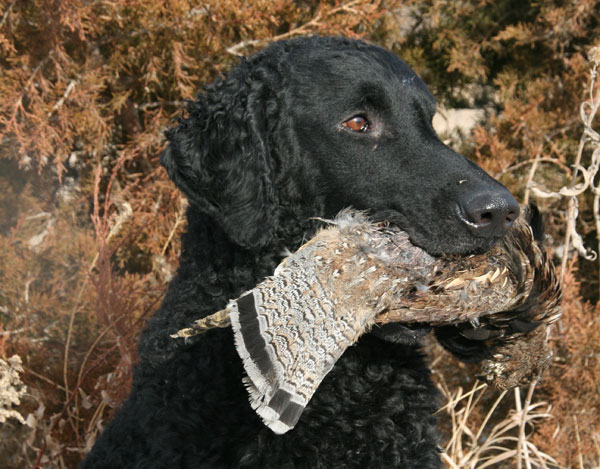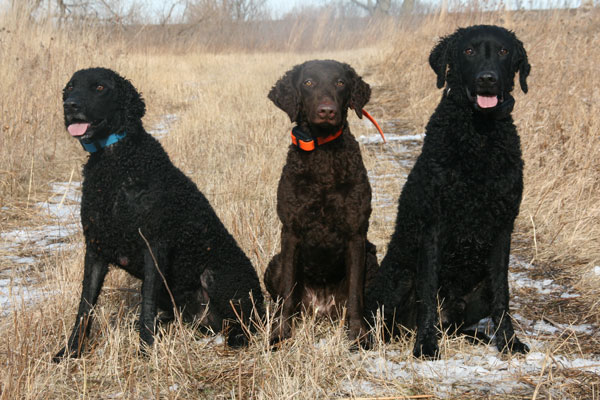
Three roosters and two hens had just flown from an unpicked cornfield across the road into a tract of seven-foot-tall prairie grass.
"Let's go after them," John Heyn and Sarah Shull volunteered as they opened up the back door of an SUV and released Rhino, Shull's four-year-old male curly-coated retriever, and Rory, Shull's six-month-old female. While perhaps not the first breed that comes to mind when an upland hunter pictures a bird dog, the curly-coats proved their worth on this trip.
The five pheasants landed close to a dirt trail that cut through the grass. When the dogs reached the birds' landing site, both put their noses to the ground in search mode.
"Rhino's getting birdy," Heyn warned as the dog's tail began to wildly whip in a wide arc that was a sure signal something good would happen.
Just as the curly-coat made a leap into a clump of cover, a rooster flushed a few inches from the dog's mouth, climbed 35 feet and leveled off in a fast flight across the South Dakota landscape. It collapsed as a pattern of No. 5s caught the bird. The quick flush and clean shot were followed by a tidy retrieve as Rhino came running in, sitting at Shull's left foot for a delivery of the bird to hand.
Both dogs started to work into the wind alongside the dirt trail, each quartering in a regular pattern.
"Watch the tails on the dogs," Heyn said as they started to shorten their cast and close in on a scent trail. "This bird is running, so we better catch up with them."
Sure enough, a rooster flew up in front of the dogs, 30 yards from the closest shotgun. Two rounds of No. 5s caught one wing, causing the bird to flutter to the ground and take off running at full-bore pheasant speed.
Three times the dogs temporarily lost the trail as the wounded bird zigged and zagged in front of them. Finally Rhino paused, looked into a clump of big blue-stem grass, then leaped with his jaws wide open. He brought the still-lively rooster to Heyn.
"I couldn't have planned a better demonstration of how curly-coats hunt pheasants," Heyn said.
All-Around Retriever
With textured curls and a sleek frame, the curly-coated retriever often triggers double-takes from onlookers. At a distance, the curly-coated retriever is often mistakenly identified as a Labrador because the curly shares the Lab's conformation and passion for finding, flushing and fetching gamebirds. But surprisingly, the curly was not descended from the Lab. Rather, the curly is thought to have been bred from the English water spaniel, the St. John's Newfoundland, the retrieving setter and the poodle, according to the American Kennel Club.
Up close, the curly is much different from a Labrador: Its coat is made up of short, stiff hairs tightly wound into ringlets covering the main body, the top of the head and the ears.
This curly hair, in either black or brown, is in a single layer that grows dense and close to the skin. It protects the dog from abrasive material on land and in water, quickly dries when wet, and resists cockleburs and other sticky vegetation.
Originally bred about 150 years ago in England to hunt upland game birds and waterfowl, the curly-coat—the first breed to be officially recognized as a retriever—is now considered a rare breed popular with the "show" people but still an excellent all-around hunting dog.
On Land and Water
"Go get Kate," Al Bronson told his son Jeremy.
Kate is Bronson's 2½-year-old curly-coat, adopted from a curly-coat rescue program in California. He and his son trained Kate themselves with some coaching from friends in a retriever club.
This day, Kate's job was to retrieve a 10-pound Canada goose that glided across a drainage ditch edged by a thick mass of willow saplings and filled with 10-foot-deep water. The shot honker had dropped straight in a big patch of cattails.
Bronson gave Kate a hand signal and a back command, and she responded by slowly walking through the willows, cautiously swimming the water and deliberately climbing up the bank on the other side. There, on a whistle toot, she stopped and waited for further instructions. One more "back" and an "over" put the dog close to the goose, and she found it after a short search. Then Kate neatly delivered the bird.
"This is a pretty typical retrieve for most curlys," Bronson said. "There's no reckless speed or flashy action, just a steady dedication to getting the job done.
"Where other retriever breeds might make a big leap off the line and hit the water with a big splash, most curlys will slow down and be more thoughtful, all of which means fewer trips to the vet for stitches, torn ligaments or broken bones. Unlike some of the more high-strung retriever breeds, the curlys seem to be genetically programmed as cooperative and laidback when in the confines of a blind or boat."
While some training and experience are necessary, in a few hunting trips these dogs will sit without a lot of fidgeting or whining.
They can easily be taught steadiness to shot so they don't charge into the water as soon as someone picks up a gun.
"The usual yard work for basic obedience should begin as a pup and should progress through each dog's introduction to field work, even though most curlys tend to be slow to mentally and physically mature," Shull says. "By the time most curlys are two years old, they are ready to perform in any hunting situation, as well as field trials and hunt tests."
Shull said she uses a force-fetching method to ensure the retrieving skills of her dogs, but many curly owners rely on their dog's natural instincts to retrieve.
In the 150-plus years of the curly-coated retriever's history, this breed has developed as a versatile gun dog with lots of natural ability that can easily be shaped by the use of standard training methods.
"No heavy-handed techniques are necessary to get a curly to effectively hunt upland game or to retrieve waterfowl," says John Heyn. "For the average hunter, teaching basic obedience and giving these dogs lots of experience on pheasants or ducks will be enough to produce a reliable gun dog anyone should be happy to have."
In the Genes
"As a general rule, curlys are not particularly needy dogs. That is, they don't knock someone over to get attention or push their heads into a person's face to demand an ear scratch," Shull says.
Because curly-coated retrievers are popular as show dogs, much emphasis is placed on the physical appearance of the breed. "The show people deserve a lot of credit for developing and maintaining the official and accepted conformation and correct coat of the curly," says Dan Strey, a curly owner from Oshkosh, Wisconsin.
As with other gun dog breeds, however, focusing exclusively on appearance in the show ring can result in a lack of natural hunting capabilities. Consequently, just because a particular curly looks good, that doesn't mean the dog can hunt well.
An upland or waterfowl hunter looking to purchase a curly-coated retriever pup or adult should consider the dog's parents' abilities and check references from other previous buyers. Ask to see the breeder's broodstock hunting in the field to evaluate those talents that are potentially passed down to their offspring. With good genes, the curly-coat is likely to become a reliable hunting dog.
"Because most curlys have such mild-mannered temperaments and so much natural ability in finding upland gamebirds and retrieving waterfowl, I think they are a good choice for the person just getting started in hunting gamebirds of any species," says Heyn.
"These dogs are usually cooperative and obedient and bond well with their owners, so they tend to hunt close to the gun—all of which makes them a good choice for the older hunter who doesn't want to chase after a dog all day," Heyn adds.
"Sure, when curlys get on running pheasants they will move out pretty fast, but even so, they will usually stay close enough so the average hunter can stay up with them—you just need to walk a little faster sometimes!"







